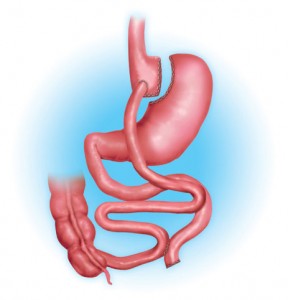Gastric Bypass (Roux-en-Y) Weight Loss Surgery
According to the American Society for Metabolic & Bariatric Surgery
(ASMBS) and the
 National Institutes of Health, Roux-en-Y gastric bypass is the current
gold standard procedure for weight loss surgery. It is the most frequently
performed operation for weight loss in the United States, accounting for
more than 90% of all weight loss surgeries.
National Institutes of Health, Roux-en-Y gastric bypass is the current
gold standard procedure for weight loss surgery. It is the most frequently
performed operation for weight loss in the United States, accounting for
more than 90% of all weight loss surgeries.
In the Roux-en-Y gastric bypass procedures, a surgeon makes a direct connection from the stomach to a lower segment of the small intestine, bypassing the duodenum, and some of the jejunum. A 15 – 60 cc proximal gastric pouch is created using several staple lines. The proximal gastric pouch is drained into a segment of the jejunum and “bypasses” the distal stomach and duodenum. The proximal part of the divided intestine is then connected to the side of the intestine that was previously attached to the pouch. The roux limb is that part of the intestine between the stomach pouch and the connection to the proximal small intestine.
The result is a sustained weight loss of >50% excess body weight in over 80% of patients. The surgery can be done laparoscopically or open. This procedure may be an option for people with a BMI between 35 and 40 who suffer from life-threatening problems for example, severe sleep apnea or obesity-related heart disease or diabetes.
Roux-en-Y Gastric Bypass Benefits
- Weight loss can average 65-80% of excess weight.
- Associated medical problems, such as diabetes, hypertension, sleep apnea, joint pain, and heartburn are improved or resolved in more than 90% of patients.
Roux-en-Y Gastric Bypass Risks
- If vitamin supplementation is not maintained vitamin deficiencies can occur.
- Dumping syndrome can occur as the result of rapid emptying of stomach contents into the small intestine which usually happens if too much sugar is consumed. Symptoms can include nausea, weakness, sweating, faintness and, on occasion, diarrhea after eating.
- In some cases, the effectiveness of the procedure may be reduced if the stomach pouch is stretched and/or if it is initially left larger than 15-30cc.
- Risks of any surgery include infection, bleeding, blood clots, leaks, strictures, and bowel obstructions.

